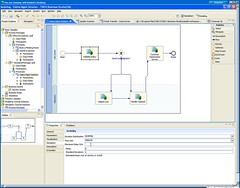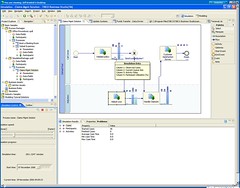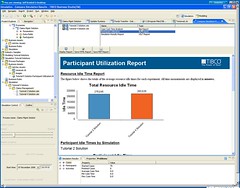I had a briefing with Jeff Kristick from TIBCO last week about their announcements today, and also had a demo of the new 1.1 release of the TIBCO Business Studio tool.
The big news is that Business Studio, the modeling, management and simulation environment, is now available at no cost — just download it from developer.tibco.com and install it. In case you’re not familiar with Business Studio, it’s an Eclipse-based application that and runs standalone without any connection to a server. Unfortunately, the press release states “TIBCO Business Studio V1.1 will be offered as the industry’s first FREE, full-featured BPM studio“, which is not true: Savvion started this trend by making their modeling tool available for free back in March at the Gartner BPM Summit. At that time, I wrote:
We’re going to see more and more of this, I believe: vendors giving away planning, modelling and analysis tools in order to raise their profile in the marketplace, and potentially drive more interest in the process engines that lie at the heart of their strategy.
 In a post in April, I talked more about vendors releasing their modeling tools for free; in fact, at the time, I mentioned that TIBCO was releasing Business Studio 1.0 as a downloadable standalone desktop application, and I made the assumption that it was free, or soon would be. Good to see that I’m right about something once in a while. 🙂
In a post in April, I talked more about vendors releasing their modeling tools for free; in fact, at the time, I mentioned that TIBCO was releasing Business Studio 1.0 as a downloadable standalone desktop application, and I made the assumption that it was free, or soon would be. Good to see that I’m right about something once in a while. 🙂
As with the other BPM vendors providing their modeling tools for free, TIBCO’s intention is not to replace a full-up modeling tool such as ARIS or Proforma with Business Studio, but to replace the use of Visio for process modeling, or to fit somewhere in between the two extremes. It can import models directly from ARIS (and, in the hopefully near future, Visio via the Zynium add-on), and export to XPDL since that’s its default serialization format. There have been some custom imports from other platforms such as Proforma, but these aren’t productized; they do publish the XSLT required to build your own importer, so it would be straightforward for someone to build it and share it around. (In theory, XPDL makes interoperability with these tools easier, although in practice, they only write to their own iProcess Modeler-compliant version of XPDL, and some of the modeling tool vendors don’t do XPDL yet.)
 I liked a number of things about the interface, especially having the simulation and modeling be two different “perspectives” on the same process model rather than having them in different applications. Simulation is really just another function within process design, so it makes sense that they’re integrated, and TIBCO’s done a nice integration here — click over to the simulation perspective, and you’ll see the simulation data right beside each activity, very similar to what I saw in the Appian process modeler that I reviewed yesterday.
I liked a number of things about the interface, especially having the simulation and modeling be two different “perspectives” on the same process model rather than having them in different applications. Simulation is really just another function within process design, so it makes sense that they’re integrated, and TIBCO’s done a nice integration here — click over to the simulation perspective, and you’ll see the simulation data right beside each activity, very similar to what I saw in the Appian process modeler that I reviewed yesterday.
I also like that they ship a number of industry samples, including the full set of standard workflow modeling patterns, and what appear to be fairly comprehensive tutorials.
There’s a few serious limitations to this version, although the near-future product roadmap overcomes all of them:
- Only a limited subset of BPMN is supported. I didn’t ask exactly what wasn’t supported, but this sounds like a bad move to me: in many cases, partial support for a standard might as well be no support at all. Full BPMN support will be in v2.0, although I didn’t catch the timeline for that.
- Business Studio doesn’t yet replace the existing iProcess Modeler: you have to export XPDL from Business Studio, then import it into the iProcess Modeler to get it hooked up to the process engine, although the eventual plans are to hook Business Studio up directly to the engine and obsolesce iProcess Modeler.
- You can’t set web services parameters, which is part of why you have to scoot over to the iProcess Modeler to finish the technical portions of your design. In early 2007, they’ll be adding the web services capabilities directly in Business Studio, then other API functionality such as calling DLLs and .jar files. Their plan is to add a “technical perspective” to the environment for specifying these interfaces, in addition to the existing modeling and simulation perspectives, although that may require some sort of authentication scheme to prevent non-technical users from accessing the technical perspective, since there’s currently no role-based security on access to the perspectives.
 As I’ve mentioned many times here before, and discussed with Jeff last week, I believe that there are compelling reasons for a browser-based process design and administration, but I’m not sure that he’s buying it yet since he claims that they have no plans for a browser-based process designer. In the meantime, a free downloadable process modeler is a great way to go, since it further lowers the barriers to potential process modelling participants. It does have the disadvantage of requiring that the user have sufficient control over their desktop environment to be able to install new software, however, which is often not the case in corporate environments.
As I’ve mentioned many times here before, and discussed with Jeff last week, I believe that there are compelling reasons for a browser-based process design and administration, but I’m not sure that he’s buying it yet since he claims that they have no plans for a browser-based process designer. In the meantime, a free downloadable process modeler is a great way to go, since it further lowers the barriers to potential process modelling participants. It does have the disadvantage of requiring that the user have sufficient control over their desktop environment to be able to install new software, however, which is often not the case in corporate environments.
The second part of TIBCO’s announcement is the general release of version 10.5 of their iProcess Suite, which is their end-to-end BPMS. Some interesting new upgrades here:
- The next version of the AJAX client workspace is released, based on the General Interface AJAX platform that they acquired two years ago. Apparently, my previous complaints about no GI support for Firefox are going to be resolved by the end of the year, too.
- There is now very granular role-based security built into the client workspace environment that allows the environment to be restricted based on the user’s role, for example, by removing controls and menu items.
- Their XML API is now fully exposed so that developers and build their own applications and user interfaces more easily, if they don’t choose to use the client workspace for all functions or users.
- Improvements to their BAM product, iProcess Insights, include the ability to drill down directly from the dashboard into the runtime product, so that the AJAX client is launched and the user can work the item that alerted them through the dashboard. Since many BPM vendors have used third-party BAM add-ons such as Celequest, many of the BPM dashboards are quite distinct silos from the execution environment; this requires a user to take note of some index information about a problem work item in the dashboard, then manually search for it in the process execution environment so that they can deal with the problem. This integration in iProcess Insights eliminates this manual step in the middle by allowing a direct drilldown.
I also had the pleasure of reconnecting in these meetings with Carl Hillier, who was a pre-sales engineer then the BPM product manager at FileNet when I was there back in 2000-2001 — he just started working at TIBCO last week. It’s a bit ironic, since Carl was originally based in the UK, and Staffware was his nemesis; since that time, the landscape has changed somewhat: TIBCO bought Staffware, and IBM bought FileNet.
